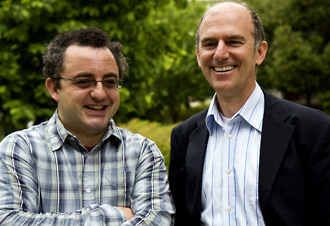Remapping the Renaissance
History books are full of stories about the contentious relationship between Europe and the Islamic world the Moorish invasion into Europe and the Crusades being the most famous examples. Two Tulane faculty members, however, are looking to turn around the notion of perpetual conflict between Islam and Christianity.

Ibrahim Kaya Sahin and Elio Brancaforte are attending a National Endowment for the Humanities seminar on "Remapping the Renaissance." (Photo by Ryan Rivet)
Elio Brancaforte, associate professor of Germanic and Slavic studies, and Ibrahim Kaya Sahin, assistant professor of history, are attending a National Endowment for the Humanities seminar this summer with the intent to take what they learn and create a new interdisciplinary course at Tulane.
The NEH seminar is called “Remapping the Renaissance: Exchange Between Early Modern Islam and Europe.”
“The premise behind the seminar is that there are artistic, cultural, scientific and technological encounters between the Islamic world and Europe that flourish from the 15th to the 17th centuries,” Brancaforte says. “People don't really study this topic enough, and haven't paid attention to these encounters.”
Furthermore, both Brancaforte and Sahin say they want to dispel the idea of eternal conflict between the two religions.
“We live in a period where people assume fundamental differences between Islam and Christianity,” Sahin says. “When we look at the historical record, we see a different picture. This summer seminar, as well as the course we are planning, is something that tells you otherwise.”
They see this type of study as a scholarly trend that is born from the current geopolitical environment that has Western armies on the ground in the Middle East. Sahin says that he believes people on both sides are growing tired of the rhetoric demonizing the other.
“We are looking to focus on mutual understanding,” Sahin says. “People are sick of the 'go get 'em' mentality. They seem to be more interested in mutual influence and interaction.”
